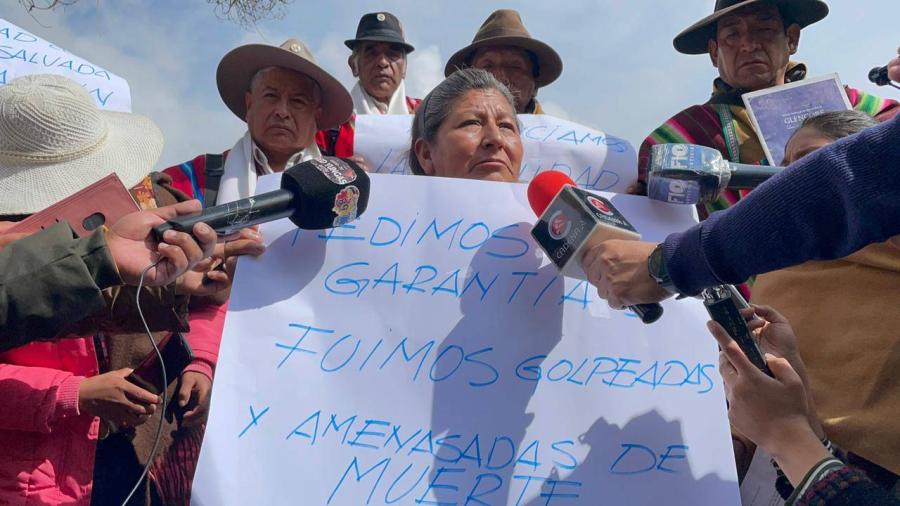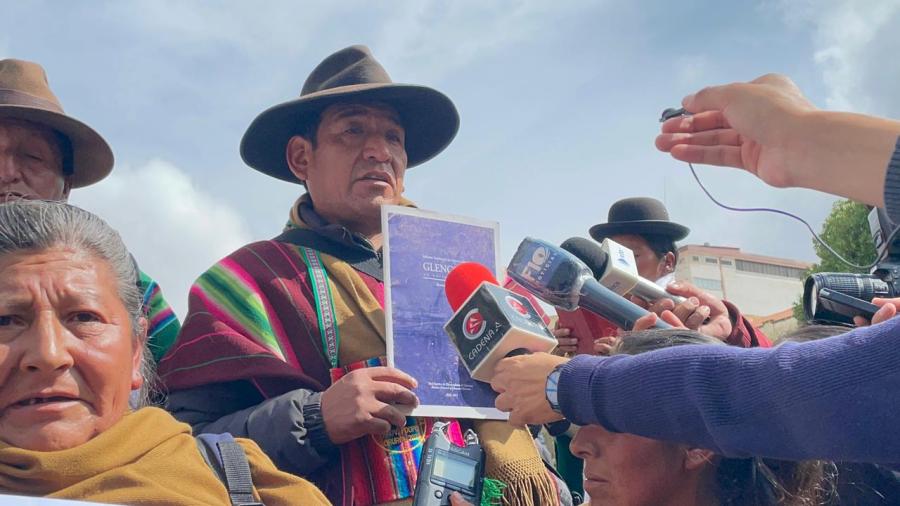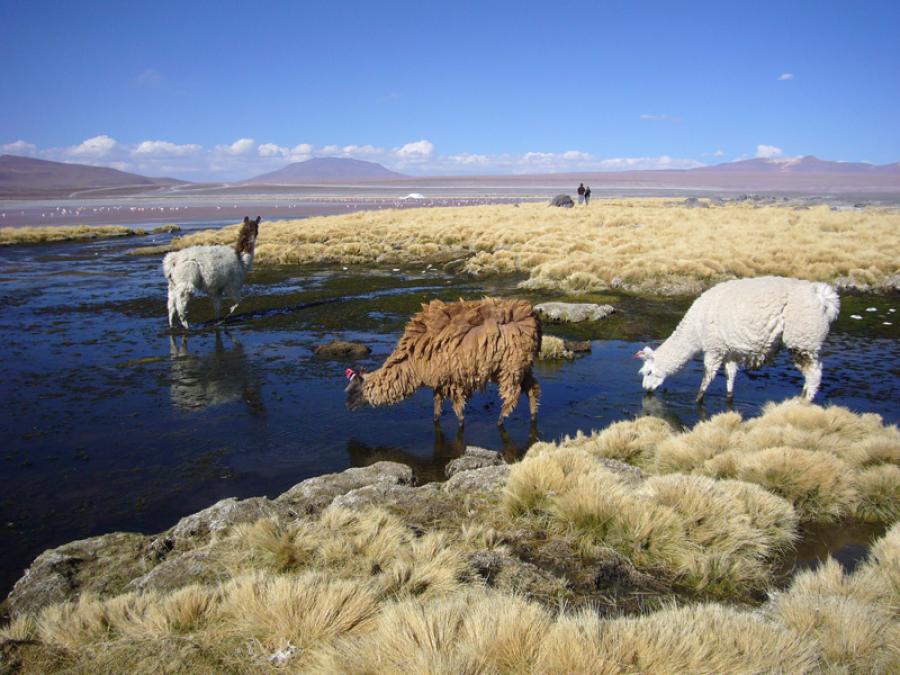
By Bobbie Chew Bigby (Cherokee)
Traveling south of the Bolivian capital La Paz—considered to be the capital city at the highest elevation in the world—the Andean highland plains provide stunning landscapes of verdant, grassy hills in some parts and rocky mountainous outcrops in others. No matter where one finds oneself traveling along these highlands, the backdrop view is ringed by sacred, snow capped mountains in the distance—the mountains of Illimani, Janq’u Qalani, Layqa Qullu, and Mik’aya, among many others. At this high altitude, everything seems to be experienced at a stronger depth, whether it is the strength of the sun's rays, the radiant colors of the land and sky, or the deeper breaths one must take to absorb enough oxygen.
On this day of travel, I am heading with Carlos Mamani (Aymara) and fellow Aymara man Wari Titu to Carlos’ home community near the town of Coro Coro in Pacaja province. In 2023, Carlos and his organization, the Research and Applied Technologies Center for al Qullasuyu (CITAQ), were named recipients of a Keepers of the Earth Fund grant from Cultural Survival for their work in revitalizing traditional salt harvesting methods in the face of pressures from transitional metal extraction. The goal of this trip is to visit Carlos’ community and Ayllu Yaribay, or the traditional Nation of Yaribay, to observe this salt cultivation process in action. We also aim to understand how these traditional practices connect his community simultaneously to the past practices of his ancestors while also providing a potential income for community members into the future.
The local church of San Francisco de Yaribay not far from Carlos’ home.
Driving into the town of Coro Coro, we immediately arrive at the frontlines of transition metal extraction that has been going on for over a century in this community. Carlos explains that Coro Coro has long been a copper mining town and one of Bolivia’s most important sources of copper. This area of the Andean highlands sits within a cupiferous, or copper-rich, land belt that extends from Lake Titicaca in the north down to the city of Chuquicamata in northern Chile, long the world’s largest copper producer. Coro Coro honors its miners and mining legacy with a statue of a miner who has a rifle raised in one hand and is operating a drilling tool in the other. This statue sends a clear message of how a miner is seen as both a provider and a defender of the community and of his family.
A statue of a miner stands proudly in Coro Coro, paying homage to the workers of the town.
But the landscape also reveals the ways that this industry has literally carved itself into the folds of the rocks and the basins, leaving behind textured wounds. Climbing up one of the rocky overlooks of the town, I glance downward from the vehicle window to take in the bird’s eye view of radiant turquoise and teal colors. These are not a natural part of the highland’s colorful panorama, but instead are the ponds of the tailings, the remnants of the processes of copper dissolution, extraction, and processing. Walking to the other side of the overlook, the natural folds of the mountains give way to jagged, terraced cuts where the mining has stripped away substantial pieces of the land where copper is dug out. Wari points at our feet and shows me just how abundant copper is in this area, as rocks along the ground clearly contain the characteristic greenish patina of oxidized copper.
Overlooking one of the largest tailing pools of the copper mine in Coro Coro.
The presence of copper in the area is abundant, as can be seen from the rocks on the ground that show an oxidized green color.
Wari and I follow Carlos’ lead down to the central heart of the mining operations where workers move around swiftly and the sound of operating machinery provides a constant hum. A mine supervisor stops briefly to speak with us and explains what the plant is responsible for. This site employs a hydrometallurgical process to extract the copper that is mined in Coro Coro. Hydrometallurgy involves several steps in order to take copper oxide ore, which normally contains a lower percentage of copper, and transform it into a product that is almost pure copper ready for industrial use. First, the ore undergoes a process of heap leaching, where the crushed ore is piled into a mound and then sprayed with sulfuric acid that seeps through the mound to the bottom. This sulfuric acid serves to dissolve the copper from the ore rock. The resulting solution that trickles down from the mound contains a higher concentration of copper that is collected in pools. The next phase of extraction requires solvents that help to separate and further concentrate the copper from the solution. Finally, a procedure of electrolysis is applied with the use of an electrical current running through the copper solution that pulls positively charged copper ions onto negatively charged plates, resulting in a copper metal product that is about 99 percent pure.
Looking across the different areas of the mine where hydrometallurgical processing of copper takes place.
The mine supervisor explains that because this mining extraction is largely an open-air process, the incidence of mal de mina, or mining-related illnesses such as silicosis, that are so prevalent among many below-ground miners in the rest of the country, is not common at all here. Nevertheless, as we drive away from the mine site, it is hard to ignore the fact that the only layer standing between these concentrated, fluorescent-colored chemicals and the earth is a black tarp lining.
The black tarp lining that stands between the earth and the acidic tailing pool.
According to Carlos, Aymara people have complex and often contradictory views towards mining, its impacts on Pachamama, and their role within this activity. On the one hand, traditional stories tell Aymara people that they had originally emerged from holes and caverns in the mountains. In this sense, these openings and caverns in the mountainous landscapes can be understood as wombs and as places of origins and birthing that are considered part of the physical body of Pachamama. At the same time, Aymara people, much like Quechua and other neighboring Indigenous Nations of Bolivia, have long relied on mining for their livelihoods, whether by force or by choice. This interconnection with mining began formally at the time of Spanish colonization with the imposition of forced conscription mining work, known as the mita system. Under Spanish rule, from the mid-1500s until the early 1800s, Indigenous communities across Bolivia and Peru were subject to the mita system, which required males to serve in the mines. The silver mined from places such as Potosí in southern Bolivia served as the economic backbone of the Spanish Empire while the majority of miners toiled in poverty for centuries. In numerous communities throughout Bolivia and across South America today, these mines remain as some of the only economic opportunities local people have to earn an income, including for many in Coro Coro. “This community has always been the source of workers for the mine,” Carlos tells me.
The textured landscape of Coro Coro, with natural rocky outcroppings on one side of town and jagged, terraced mine cuts and blasted hillsides dominating the other side.
As we drive further away from the mine site and back toward Carlos’ community, he points out places in the landscape that show the mark of traditional forms of enterprise far predating the industrial copper mine we have just seen. To the untrained eye, these places look only like clustered arrangements of stones. But Carlos explains that these are uyllus, or the traditional corrals for llamas, and they serve as evidence of the salt industry that was—and that Carlos, with the support of Cultural Survival, is trying to bring back to provide community members with an income. Even though these corrals are no longer in use, the large presence of llamas was key to this industry. “The llamas were our traditional form of transportation. We depended upon the llama to be able to transport our key product, the salt we harvested. Our ayllu, or traditional Nation, was located here within this specific area that was conducive to salt harvesting. There are even Spanish chronicles that say that our ayllu was here specifically because this location was ideal for cultivation and harvest of salt,” Carlos says.
From these ancient corrals that represent the traditionally used llama-powered transportation, Carlos leads us to the heart of the salt production that he is helping to revitalize. On both sides of the roads, we pass through chakras, or fields of potatoes that are harvested and often dehydrated, forming the most important staple food of the highlands. Carlos tells me that, “coming from North America, you are a daughter of the corn. But we here in Bolivia are children of the potato. The potato is essential for us.”
Carlos Mamani looking out at the remnants of the uyllus that served as corrals for llamas, the animals crucial for traditional transportation, industry, trade, and sustenance.
We finally arrive at a blindingly bright landscape that is dotted by salt parcels stretched across the ground. “These are the chakras de sal, or salt fields,” Carlos says. “Just like you have seen the chakras of potatoes, just as important to our people are the fields of salt that we tend.” I quickly learn that the use of farming terms to describe the process of salt harvesting goes beyond simply metaphors or analogies— this cultivation of salt is seen as a process that is akin to any other form of agriculture. Carlos emphasizes that it requires just as much care, attention, and hard work.
Carlos leading us out to the salt fields where harvesting takes place.
The square parcels, or fields, where the salt is left to accumulate as water evaporates are fed by the salty sources of water that flow naturally in this area. Salt is normally cultivated during Bolivia’s dry season, which lasts from April until November; the rainy season from November onwards makes the evaporation process impossible. Carlos leads me to a round well in the ground lined with stones and shows me that this is the ojo de agua (eye of water), a central collection point of salty water. “We have constructed canals from this eye of water that allow us to run this salt water from this source point to the fields. In this way, we plant the salt and then continue to water the salt by increasing the water flow,” he says.
The ojo de agua serves as a primary source of salty water brine that is channeled to the parcels for evaporation.
Once the water in this saltwater mix begins to evaporate, salt is left behind. “Did you know that salt blooms into beautiful flowers?” Carlos asks with a grin. He shows me what he means by pointing to the snowflake-like salt crystals that have bloomed within specific fields and along their edges, each unique and distinct in their shapes and sizes. As the salt crystals continue to blossom, grow, and thicken, they are eventually harvested, normally by cutting them into large blocks that are then dried, stacked, and stored at the side of the salt fields. In one year, these fields can normally yield three to four harvests of salt. Throughout the cultivation process, the salt field parcels and their mud walls must consistently be maintained and repaired. Because of the intensiveness of the labor, Carlos says that this salt harvesting was commonly viewed by Aymara people as men’s work, but today it has become a job that men and women share. To be able to commercialize the salt, the addition of iodine is required before it is sold. Carlos explains that part of the KOEF funding has gone towards the purchase of these tools and the electrical connection for processing, iodizing, and bagging the salt.
Wari Titu collects some of the salt blossoms that have formed in the parcel.
Admiring the unique crystals of the salt that has been cultivated.
Salt that has been harvested, cut into blocks and left to dry.
An Aymara woman from a neighboring community who carefully repairs the walls of a salt field parcel while her daughter watches.
Salt cultivation has traditionally been seen as deeply important work not only because it was at the center of international Indigenous trade that connected ayllus such as Carlos’ Ayllu Yaribay with places as far away as Cusco during the period of the Incan Empire, but the salt itself is seen as a sacred gift of the Pachamama. At one edge of the salt fields, Carlos points to a rocky hill that from our vantage point resembles the natural curves of a woman. “We see in this hill a young woman named Maria Lupisa; she is the guardian of the salt. We understand that the salt that we harvest comes from Maria Lupisa’s breasts, just in the same way that a mother provides milk that nourishes a baby. Maria is a potent name because it is related to the Virgin Mary. But Maria Lupisa is also important because from our oral history, we have understood that Maria Lupisa was a trusted companion of the Aymara warrior Tupac Katari. Maria was the one who cared for the children and watched over rescued treasures while Tupac Katari led other Aymara in a battle to expel Spanish colonizers.”
Carlos Mamani (right) points to the hillside that is viewed as an embodiment of Maria Lupisa, guardian and source of the salt, while discussing this story with a fellow community member and salt harvester (left).
Tupac Katari was, and continues to be, one of the most inspirational Indigenous leaders in Bolivia’s history, leading one of the most significant rebellions against the Spanish in 1781 that lasted nearly six months. As an Aymara leader, he assembled an army of about 40,000 men and also worked closely alongside his wife and sister. He was ultimately captured by the Spanish forces and brutally murdered and dismembered, his arms and legs tied with ropes to four different horses who pulled his body apart. His final words are remembered as, “Nayawa jiwtxa nayjarusti waranqa waranqanakawa kut’anipxani” (“I die but will return tomorrow as thousands and thousands”). These words, and Katari’s legacy, have been strong inspiration for generations of Indigenous people across the Americas who have followed in taking up the cause of defending traditional Nations and their sovereignty, cultures, and relationships to Pachamama.
For Carlos and his community, the figures of Maria Lupisa and Tupac Katari and the ancient industry of salt harvesting are etched deeply and meaningfully into the highland landscape around us. Carlos asserts that beyond income generation, another important goal of reconnecting his people to the salt is to make them aware of the potential threats these communities face in defending and revitalizing their relationships with this sacred substance. These threats include not only potential environmental damage from the nearby copper industry, but also from another white mineral that lies in abundance below the ground in Bolivia.
The rush to access lithium for the so-called green energy transition has made Bolivia, home to the world’s largest natural salt flat of Uyuni in the country’s south, the epicenter of the Lithium Triangle. Given this strategic positioning, the Bolivian government nationalized lithium production in 2008, with laws stipulating that anything coming from below ground and then evaporated is a resource of the State. While at face value this would appear to apply primarily to lithium reserves, the underground and evaporative processes are also part of the salt harvesting Carlos and his community are revitalizing. Concerned about the potential for State interference in the revival and commercialization of this process, Carlos feels that it is essential for people in his ayllu and across Bolivia to understand about this law, but also understand about the sovereignty of their ayllus and traditions that predate the State.
This connection to salt represents a link for Aymara people not only to Pachamama, but is a symbol of the deep knowledge, international trade networks, and sophisticated capabilities of ayllus in exerting their sovereignty from times of the deep past into the present. Yet Carlos and his community are not alone in their efforts to reassert the sovereignty of their ayllus and recuperate their Traditional Knowledge in the face of mining. One need only to follow the trail of salt further south, deep into the heart of Bolivia’s Lithium Triangle and onto the frontlines of today’s extraction and mining for the “green” energy transition.
Acknowledgments
Particular thanks go to Carlos Mamani and his family for being such kind and generous hosts while in his community. Gratitude as well to Wari Titu for his storytelling and knowledge sharing while driving across the highlands.
--Bobbie Chew Bigby (Cherokee) is a Postdoctoral Research Fellow at the University of Waterloo, Ontario, Canada, where she researches the intersections between Indigenous-led tourism and resurgence.
Top photo: Carlos Mamani (right) sits with family members in his home community in Ayllu Yaribay and prepares to have lunch.
All photos by Bobbie Chew Bigby.



